| Summary | 4th WHITRAP World Heritage Dialogue |
| Author:MN. Tournoux PublishDate:2022-09-27 Hits:2464 |
The 4th WHITRAP Shanghai World Heritage Dialogue was held on 14 September 2022. It focused on “World Heritage, Climate Change and Resilience -- Conserving Heritage and Promoting Heritage as a solution”. For the video of the activity, please visit: http://heritap.whitr-ap.org/index.php?classid=12497&id=38&t=show 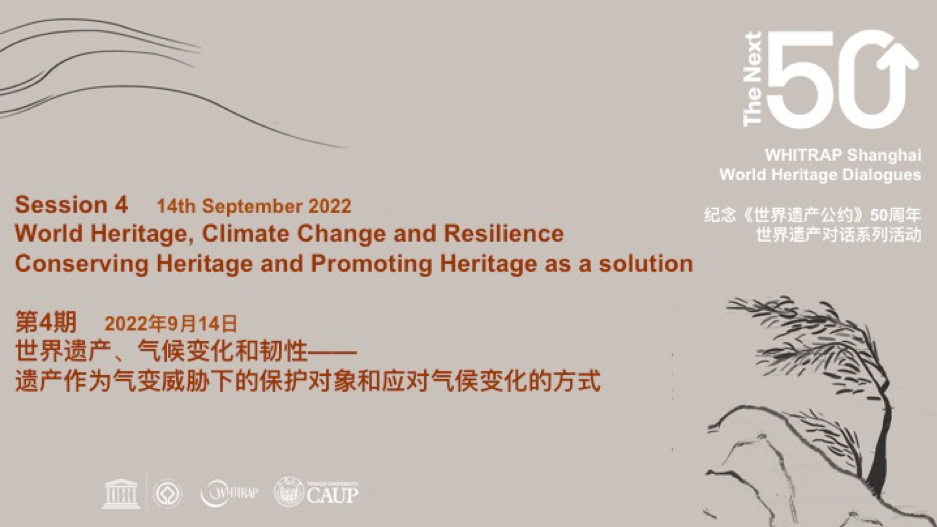
01 Background
The 6 monthly online thematic Dialogues series are organized by WHITRAP Shanghai and hosted by the College of Architecture and Urban Planning (CAUP), Tongji University and their outcomes will be presented and further discussed and presented on 15-16 November in an international conference on "World Heritage and Urban-Rural Sustainable Development: Resilience and Innovation" also organized by WHITRAP and CAUP Tongji University. The 4th Dialogue was devised and chaired by Marie-Noël TOURNOUX, Project Director WHITRAP Shanghai and co-organized and moderated by Dr. MU Xingyu, Project Director WHITRAP Shanghai. Seven experts from the Asia and Pacific Region and North America were invited to share their views on the topic of World Heritage, Climate Change and Resilience. Patricia O’DONNELL, President of ICOMOS Scientific Committee on Cultural Landscape
Prof. LIU Gengnian, Peking University, China
Erin ROSE, Executive Office at Gunditj Mirring Traditional Owners Aboriginal Corporation
LI Jinsheng, Senior expert in urban planning in China
Associate Prof. LI Ang, Law School of Hainan Normal University
Diane MENZIES, ICOMOS Scientific Committee on Cultural Landscape
Associate Prof. SONG Feng, Deputy Director WHITRAP Beijing
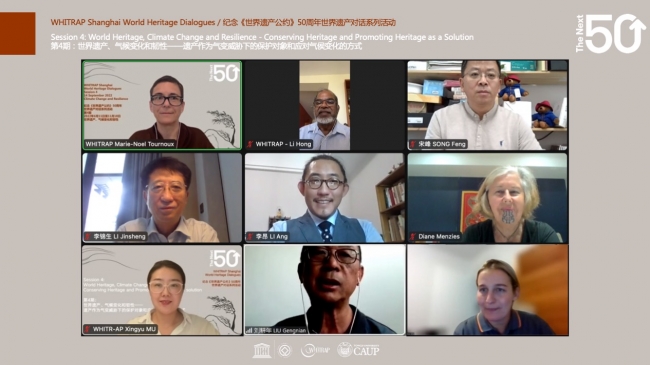 02 Opening
After welcoming the participants and audience, the Chair, recalled the objective of the Dialogues, imagining the Next 50: World Heritage as a source of resilience, humanity and innovation, and reiterated the 4th Dialogue aimed to explore what tools can be used for safeguarding heritage threatened by climate change and discuss how in a time of crisis heritage can be a solution to confronting climate change in conservation practices as well as a means to mitigate climate change beyond the conservation field itself. She recalled the international discussions of the 70s on the human environment and the limits to growth. She stressed the importance of reflecting on the role and function of heritage to address the climate crisis and rethink the relationship between conservation and development. 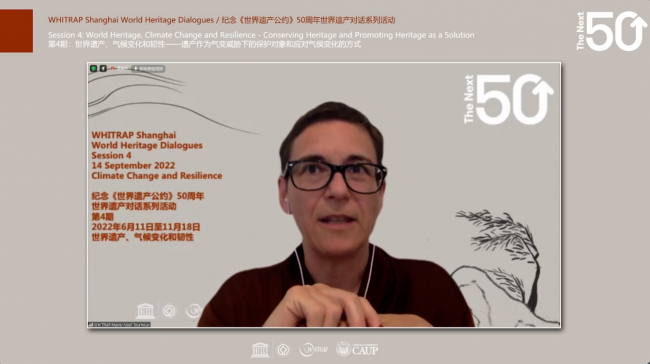 03 Introduction
MU Xingyu introduced the 4th Dialogue's theme "World Heritage, Climate Change and Resilience -- Conserving Heritage and Promoting Heritage as a solution". 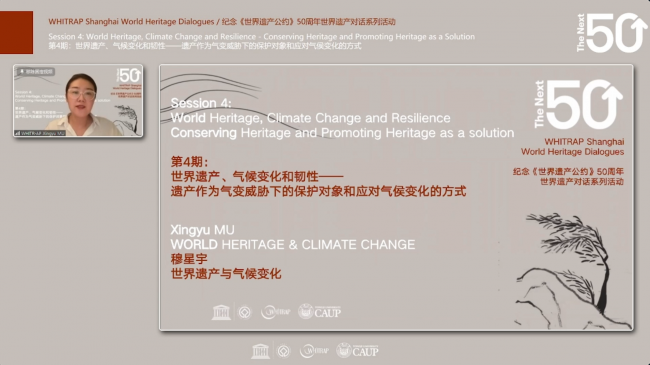 MU Xingyu started by presenting the World Heritage Convention and its Article 11.4 which refers to “calamities and cataclysms; serious fires, earthquakes, landslides; volcanic eruptions; changes in water level, floods and tidal waves”. She described the evolution of concepts regarding climate change, the key organizations involved, the existing international statutory tools, and actions undertaken in relation to heritage and World Heritage. In particular, she focused on the Intergovernmental Panel on Climate Change (IPCC), which provides policy makers with regular scientific assessment reports on the current state of climate change and on the United Nations Framework Convention on Climate Change (UNFCCC), which currently is one of the most important conventions in the global response to climate change. She highlighted the differences between the IPCC and the UNFCCC definitions of climate change. She continued by explaining the World Heritage field’s response to the impacts of climate change. She explained how the World Heritage Committee closely monitored the impacts and threats to World Heritage properties and requested field research. The discrepancy between the two IUCN outlooks showed that UNESCO World Heritage sites are increasingly affected by climate change and time is running out. She further presented how the UNESCO World Heritage Centre carries out the World Heritage Committee decisions. How it reached a basic consensus on climate change impacts on World Heritage, provided a system of tools such as risk assessment, climate adaptation framework, climate mitigation framework and mitigation tools, which were initiated for implementation at international, national and site levels, and meanwhile gained relevant experience regarding the role of local knowledge and wisdom. Its work has paid much attention to reinforcing synergies between sectors and international agendas and conventions.
04 Pecha Kucha
In her video presentation, Patricia O’DONNELL discussed Urban Heritage, Climate Change and Resilience: City Open Space as a Solution. She highlighted in particular how nature itself, planting trees for example could help mitigate the impacts of climate change in urban areas. 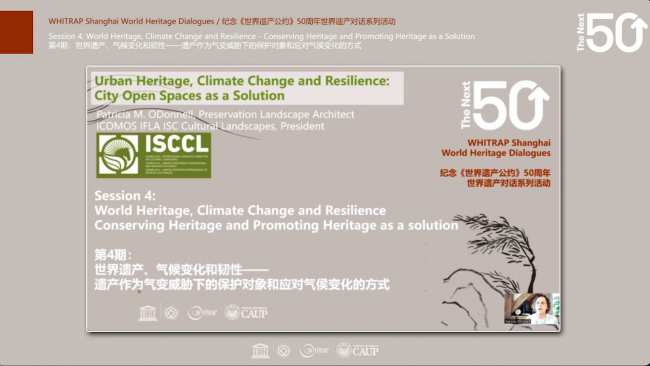 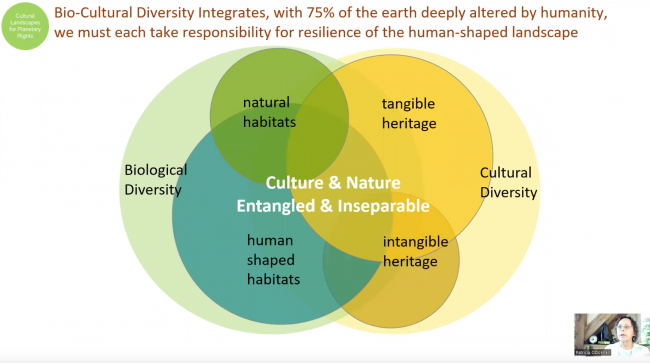 Prof. LIU Gengnian presented the understanding of World Heritage and Climate Change in the context of the evolution of the earth. World Heritage is a product of the evolution of the earth, of civilization and nature. World Heritage sites and global climate change needs to be analysed scientifically and historically. 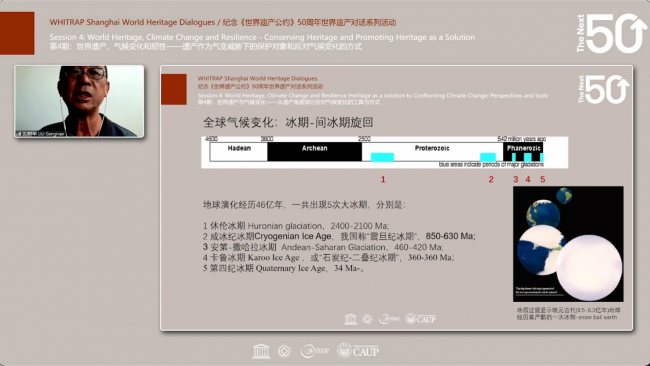 Erin ROSE in her presentation on the Budj Bim Cultural Landscape explained the heritage values of the property, such as its traditional water management system and the key monitoring and management challenges. 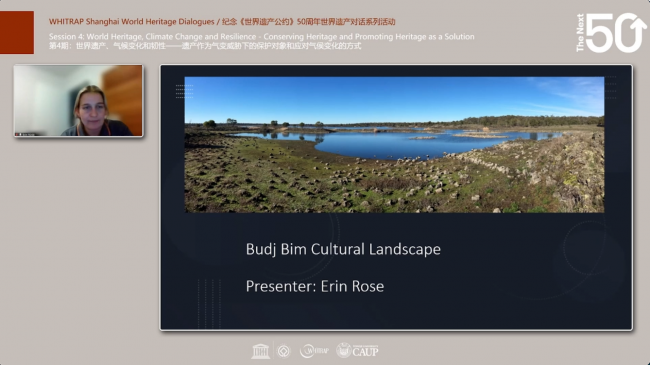 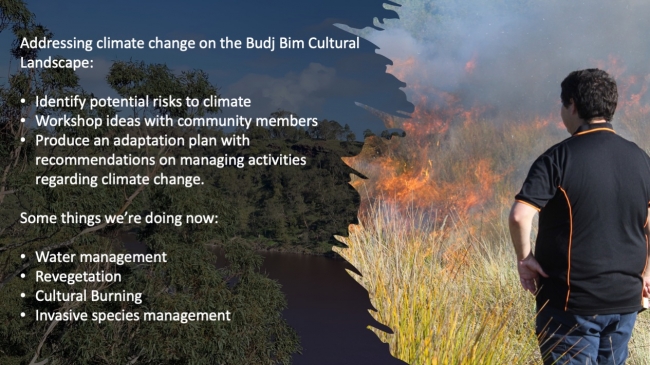 LI Jinsheng presented the case of climate change and traditional architectural heritage in Shanxi and some of the key steps to respond to climate change threats through research, monitoring, governance, and developing adequate competency and institutional frameworks. 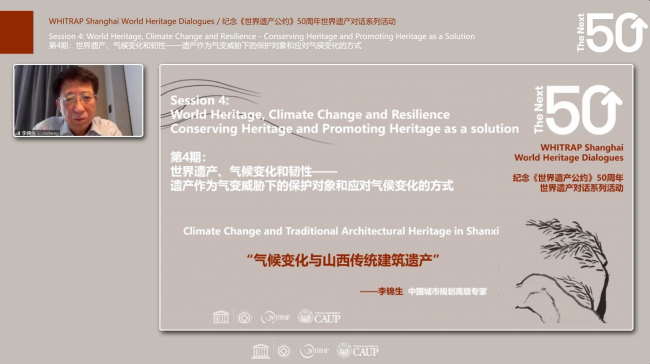 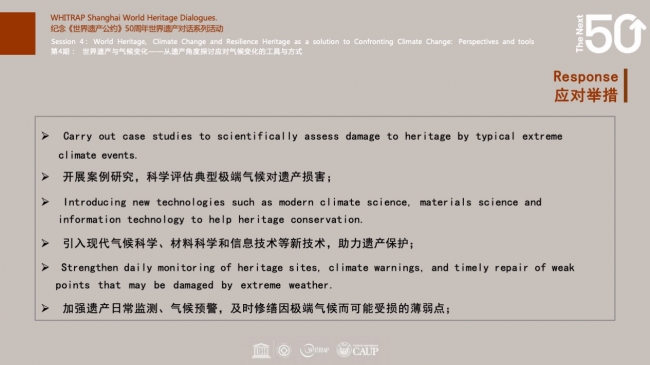 Associate Prof. LI Ang provided a comprehensive overview of legal frameworks from the international level to local levels. He addressed the different conceptual approaches within legal systems and the challenges of developing adequate legal frameworks and implementing them. 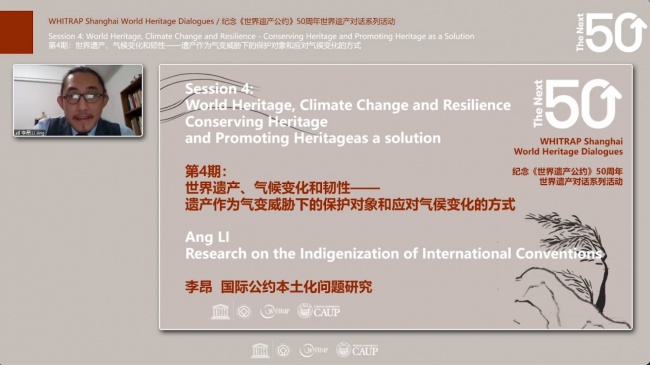 Diane MENZIES, in her presentation on Urgency in saving our earth: Adapt old knowledge about change to protect our heritage, underlined how changes in the environment have been observed for many years. Adaptions have been made of the understanding that humans and heritage, animate and inanimate, physical and metaphysical, are intertwined. 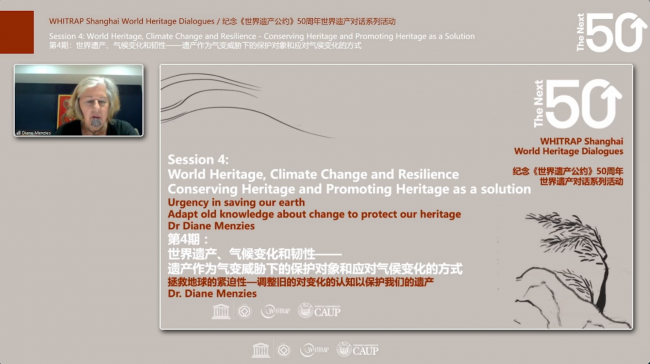 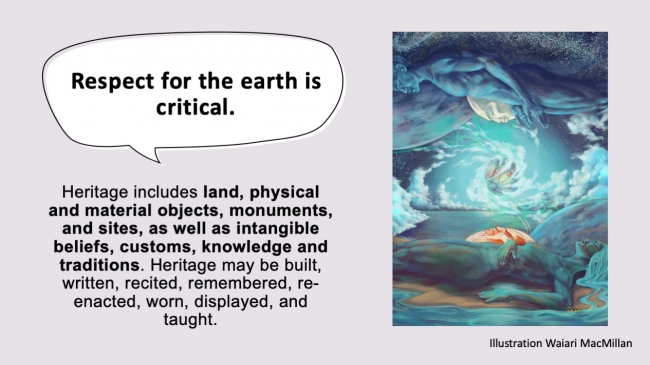 Associate Prof. SONG Feng proposed A Dialectical Perspective on the Relationship between Climate Change and World Heritage, where he presented the functions and roles of World Heritage in climate change governance at the international and national levels and the objectives of taking action to mitigate the impact of climate change.
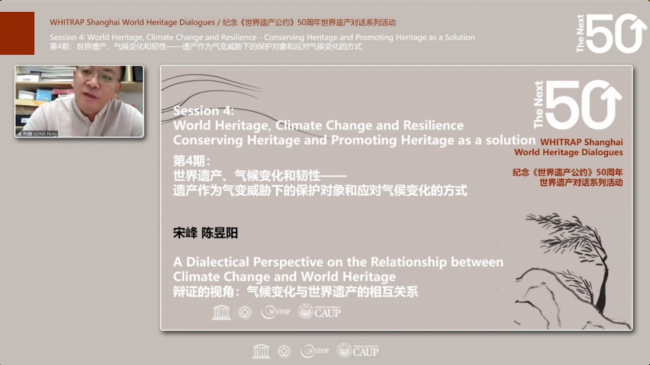 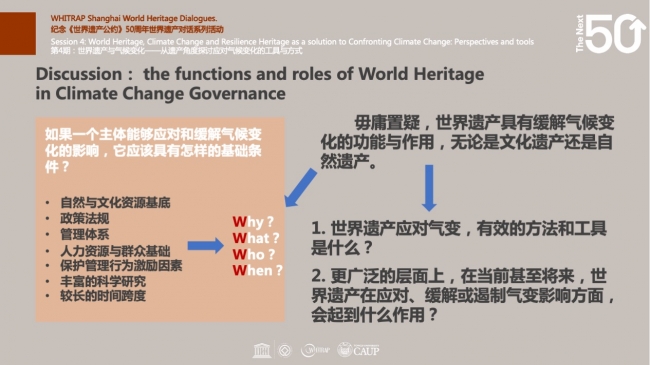
05 Round Table
In this session, discussants were asked to reflect on two questions: 1) What tools do we need to help World Heritage confront climate change? 2) If World Heritage is a solution to confront climate change in its broader context, what are the tools we need? 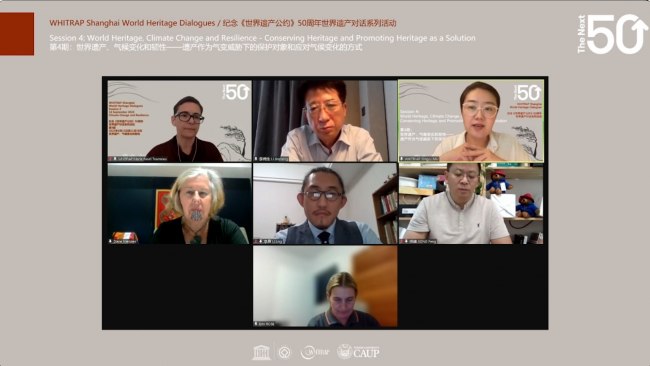 Both the billions of years of the earth’s physical evolution and the thousands of years of human wisdom about the environment and centuries of human management of the environment were discussed when addressing the critical issue of knowledge on climate change and its impacts on heritage to allow for the development of adapted policies, emergency and crisis responses, and strengthening monitoring of sites and restoration. Discussants highlighted how people from different societies had different viewpoints on caring for and exploiting their environment based on their spiritual and philosophical understandings of the place of humans in the Universe. These different beliefs influence the approach to managing resources, and threats. They define as well the responsibility of people towards the Earth, with humans being both responsible for their woes and victims of their actions. Based on these understandings, the role and function of heritage are considered differently. The participants demonstrated how the intrinsic qualities of heritage, such as traditional building techniques, or ancient water management systems, restoring ecosystems were more resilient to threats. All participants highlighted the importance of adequate institutional frameworks to allow for detailed research and assessing changes and impacts using both high-tech and traditional knowledge systems. They put forward the idea of World Heritage itself as a means to monitor climate change. Accordingly, customary tools and modern technologies could facilitate monitoring theenvironment and safeguarding the values of World Heritage. Participants stressed scientific research and observation should not only be top-down but require public engagement. People often shouldered the responsibility and accountability of observation, maintenance, monitoring, and education of heritage. They also stressed the need for robust and binding legal mechanisms, which should equally further acknowledge traditional systems in new systems. They also highlighted the crucial need to bridge the gap between global and local regulations. The critical issue of competency and human and financial resources to implement and control the institutional and legal tools was underlined. How to respond to disappearing heritage due to natural or human-made threats was equally addressed by underlining the need for further and detailed documentation. Throughout the Round Table, the participants stressed the need for stronger interconnections, as different aspects of heritage and environment were connected and different stakeholders were involved. 06 Wrap Up
Marie-Noël TOURNOUX summarized the key points of the Dialogue. It showcased the strength and relevance of connecting modern systems and traditional knowledge systems in the field of research on climate change as well as in developing legal frameworks and tools. It stressed the importance of assessing and monitoring the impacts of threats on World Heritage sites. The discussion strongly advocated prioritizing research on climate science, the resilience of heritage or its weaknesses. They highlighted equally resorting to nature itself as a means of mitigating the impacts of climate change on cultural sites. The Dialogue highlighted the role of people as beneficiaries and stakeholders in particular regarding governance, knowledge development and dissemination of heritage values. The next Dialogue on World Heritage large scale properties is on Wednesday 12 October.
Contributed:Marie-Noël TOURNOUX
Typeset:JI Zhenjiang(Intern)
|
- News | WHITRAP Shanghai and CNR-ISPC bilateral meeting
- News | WHITRAP meets Cité de l’Architecture et du Patrimoine
- WHITRAP Hosting "Workshop on Preliminary Assessment for National Focal Points of the Asia Region" in Chengdu
- WHITRAP Shanghai meets UNESCO
- INTERNATIONAL CONFERENCE PRELIMINARY ANNOUNCEMENT & CALL FOR PAPERS
- Observation of the 46th Session of the World Heritage Committee
Copyright © 2009-2012 World Heritage Institute of Training and Research-Asia and Pacific (shanghai)


